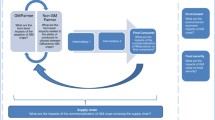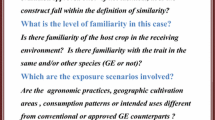Abstract
Systematic reviews and meta-analyses are now routinely used to assess both the benefits and risks of medical treatments and drugs. The application of meta-analyses in the medical world is more straightforward than in the environmental arena because appropriate control treatments and measures of impact are more easily agreed on in medicine. Nonetheless, meta-analysis has great potential not only to inform specific regulatory decisions in the arena of plant biotechnology, but also to inform general risk management policy. Within the realm of genetically modified (GM) crops, meta-analyses provide quantitative syntheses of the benefits, risks, and information gaps of these emerging technologies. In this context, several published meta-analyses have examined the risks of insect resistant crops to nontarget organisms and the risk of outcrossing due to gene flow from GM crops. The three most critical challenges when applying meta-analysis to plant biotechnology risk analysis are: (1) identifying the appropriate comparison—risk compared to what baseline?; (2) using the meta-analysis to help identify the best levers for risk management; and (3) using the meta-analysis to estimate the probability of rare, larger magnitude hazards that are unlikely to occur during short duration studies. Meta-analysis is an important tool for risk analysis and risk management because patterns that might never be captured in individual studies can emerge from the aggregate collection.

Similar content being viewed by others
References
Antman EM, Lau J, Kupelnick B, Mosteller F, Chalmers TC (1992) A comparison of results of meta-analyses of randomized control trials and recommendations of clinical experts: treatments for myocardial infarction. J Am Med Assoc 268:240–248
Damgaard C, Kjellsson G (2005) Gene flow of oilseed rape (Brassica napus) according to isolation distance and buffer zone. Agric Ecosyst Environ 108:291–301
Dickersin K (2010) To reform U.S. health care, start with systematic reviews. Science 329:516–517
Duan JJ, Marvier M, Huesing J, Dively G, Huang ZY (2008) A meta-analysis of effects of Bt crops on honey bees (Hymenoptera: Apidae). PLoS One 3(1):e1415. doi:10.1371/journal.pone.0001415
Duan JJ, Lundgren JG, Naranjo S, Marvier M (2010) Extrapolating non-target risk of Bt crops from laboratory to field. Biol Lett 6:74–77
Hawes C, Haughton AJ, Osborne JL, Roy DB, Clark SJ et al (2003) Responses of plants and invertebrate trophic groups to contrasting herbicide regimes in the Farm Scale Evaluations of genetically modified herbicide-tolerant crops. Philos Trans Roy Soc Lond B Biol Sci 358:1899–1913
Lövei GL, Andow DA, Arpaia S (2009) Transgenic insecticidal crops and natural enemies: a detailed review of laboratory studies. Environ Entomol 38:293–306
Lusk JL, Jamal M, Kurlander L, Roucan M, Taulman L (2005) A meta-analysis of genetically modified food valuation studies. J Agric Resour Econ 30:28–44
Marvier MA (2002) Improving risk assessment for nontarget safety of transgenic crops. Ecol Appl 12:1119–1124
Marvier M, McCreedy C, Regetz J, Kareiva P (2007) A meta-analysis of effects of Bt cotton and maize on non-target invertebrates. Science 316:1475–1477
Naranjo SE (2009) Impacts of Bt crops on non-target organisms and insecticide use patterns. Perspect Agric Vet Sci Nutr Nat Resour 4:1–23
Powell JR, Levy-Booth DJ, Gulden RH, Asbil WL, Campbell RG et al (2009) Effects of genetically modified, herbicide-tolerant crops and their management on soil food web properties and crop litter decomposition. J Appl Ecol 46:388–396
Pullin AS, Stewart GB (2006) Guidelines for systematic review in conservation and environmental management. Conserv Biol 20:1647–1656
Ricroch A, Bergé JB, Kuntz M (2010) Is the German suspension of MON810 maize cultivation scientifically justified? Transgenic Res 19:1–12
Schier A (2006) Field study on the occurrence of ground beetles and spiders in genetically modified, herbicide tolerant corn in conventional and conservation tillage systems. J Plant Dis Protect 113:101–113
Teeters JL, Harris KD, Millman KJ, Olshausen BA, Sommer FT (2008) Data sharing for computational neuroscience. Neuroinformatics 6:47–55
Weed DL (2005) Weight of evidence: a review of concept and methods. Risk Anal 25:1545–1557
Wolfenbarger LL, Naranjo SE, Lundgren JG, Bitzer RJ, Watrud LS (2008) Bt crop effects on functional guilds of non-target arthropods: a meta-analysis. PLoS One 3:e2118
Conflict of interest
The author M. Marvier declares that the research was not sponsored and that she has no conflict of interest.
Author information
Authors and Affiliations
Corresponding author
Additional information
Conference Proceedings: “Decision Making and Science—The Balancing of Risk based Decisions that Influence Sustainability of Agricultural Production” 7th and 8th October 2010 in Berlin, Germany. Sponsored by the OECD Co-operative Research Programme.
Rights and permissions
About this article
Cite this article
Marvier, M. Using meta-analysis to inform risk assessment and risk management. J. Verbr. Lebensm. 6 (Suppl 1), 113–118 (2011). https://doi.org/10.1007/s00003-011-0675-6
Published:
Issue Date:
DOI: https://doi.org/10.1007/s00003-011-0675-6




